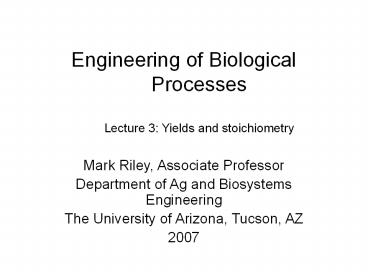Engineering of Biological Processes Lecture 3: Yields and stoichiometry - PowerPoint PPT Presentation
Title:
Engineering of Biological Processes Lecture 3: Yields and stoichiometry
Description:
Based on 1 mole of C in the input. CHmOn a O2 b NH3. c CHaObNd dH2O eCO2 ... Normalized to 1 mole of carbon source compound ... – PowerPoint PPT presentation
Number of Views:254
Avg rating:3.0/5.0
Title: Engineering of Biological Processes Lecture 3: Yields and stoichiometry
1
Engineering of Biological ProcessesLecture 3
Yields and stoichiometry
- Mark Riley, Associate Professor
- Department of Ag and Biosystems Engineering
- The University of Arizona, Tucson, AZ
- 2007
2
Objectives Lecture 3
- Biosynthetic processes (anabolic)
- Case studies - cholesterol
- Stoichiometry and modeling cellular requirements
- "You are what you eat"
3
Stoichiometry
- Provides information on fundamental constraints
- Substrate conversion to product
- Cell mass from substrate
4
Yields and yield coefficients
- Mass based kg of this from kg of that
- Y (output / input)
- Y x/s
- Y p/s
- Y ATP/O2
- Ymx/s maximal yield of cell mass from substrate
5
Yield
- Overall
- Instantaneous
- Ratio of rates
- Ratio of yields
- Theoretical Y
- Observed Y
6
Cell metabolism Y lactate / glucose ranges
from 2 to 0 based on environment The basic
reaction is Glucose 2 Pi 2 ADP ? 2 Lactate
2 ATP 2 H2O
7
- Yield of cell mass from substrate
- Y x/s
8
(No Transcript)
9
Cell composition
CHxOyNz
10
- In a very simplistic interpretation of
metabolism, the following applies - Cells medium O2 (sometimes) ? more cells
product CO2 H2O - Medium contains sugars, amino acids, cofactors
and the elements in the previous table.
11
Stoichiometric calculations
- Based on 1 mole of C in the input
- CHmOn a O2 b NH3 ?
- c CHaObNd dH2O eCO2
- This is normalized to 1 mole of C. Could also be
normalized to 1 mole of the C source compound - Perform elemental balances to determine the
unknown values of the cofactors
12
Example
- C6H12O6 a O2 b NH3 ?
- c C4.4H7.3O1.2N0.86 dH2O eCO2
- 2/3 of the glucose C goes to biomass
- What are the stoichiometric coefficients, and
Yx/s, Yx/O2?
MWglucose 180 MWcell 89.62 MWoxygen
32 MWammonia 17
13
Generalized growth reaction
- C6H12O6 a NH3 b O2 ? a CH1.8O0.5N0.2
- b CHxOyNz gCO2 dH2O
- Normalized to 1 mole of carbon source compound
- Where a, b, a, b, g, d, x, y, z depend on the
type of cell involved. - a, b, a, b, g, d, are stoichiometric
coefficients - When little info is available about cell
composition, use an approximated cell composition
of CH1.8O0.5N0.2 - This yields a MW of a cell 24.6
14
Generalized growth reaction
C6H12O6 a NH3 b O2 ? a CH1.8O0.5N0.2 b
CHxOyNz gCO2 dH2O
g of cells from g of glucose
15
Lack of information
- Unfortunately, the elemental balances often do
not provide enough information to completely
solve for the stoichiometric coefficients.
16
Respiratory quotient
- RQ YCO2/O2
- Molar basis
- Moles of CO2 produced from moles of O2
- Provides information on the metabolic state of
the cell - A high RQ means that much CO2 is produced and
hence the metabolism is operating at high
efficiency
17
Aerobic metabolism
- CHmOn a O2 b NH3 ?
- c CHaObNd d CHxOyNz eH2O fCO2
- RQ ?
18
Degree of reduction
- Electron balance
- of available electrons / g of atomic C
- Or, this can be described as
- of available electrons / of Cs
- Provides another independent equation
19
Degree of reduction
- C 4
- H 1
- N -3
- O -2
- P 5
- S 6
- CO2 4 (C) -2 (O) 0
- C6H12O6 6(4) 12(1) 6(-2) 24
- g 24 / 6 ( carbon atoms) 4
- C2H5OH 2(4) 6(1) (-2) 12
- g 12 / 2 ( carbon atoms) 6
20
Example yeast grown on glucose
- C6H12O6 0.48 NH3 3 O2 ?
- 0.48 CH1.8O0.5N0.2 3.12CO2 4.32H2O
- To grow yeast to 50 g/L in a 100,000 L reactor,
determine - a) mass of glucose and ammonia required
- b) O2 required
- c) Yx/s and YX/O2
MWglucose 180 MWcell 24.6 MWoxygen
32 MWammonia 17
21
HW 1 questions
- What kind of cell would you use to produce
androstenedione? Your answer should describe the
attributes of such a cell (don't just state, "a
cell that produces andro"). An answer longer
than 4 sentences is too much. - Producing cholesterol is an energy intensive
process. How much energy (in terms of of ATP
molecules) is consumed in producing one
cholesterol molecule from a source of glucose?































